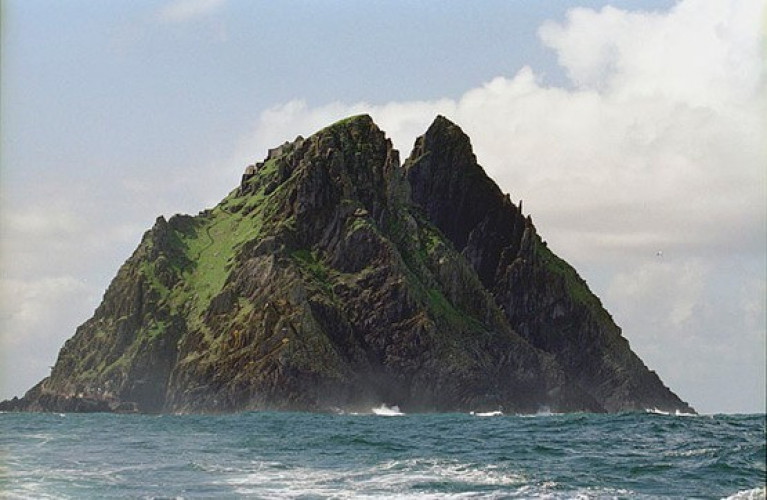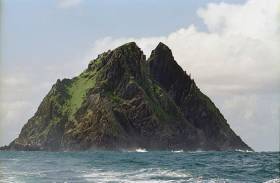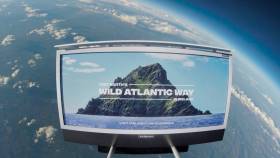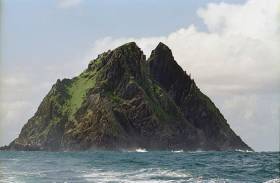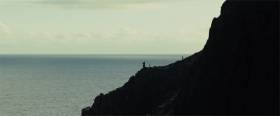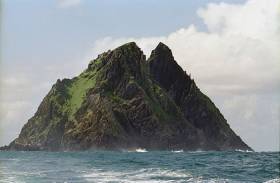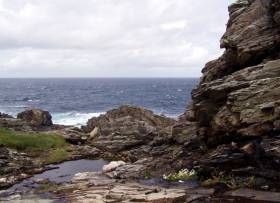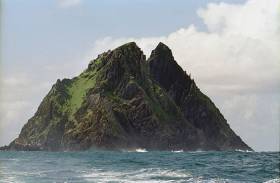Displaying items by tag: Star Wars
Former Skellig Michael Site Manager Says Star Wars Film Shoot Was ‘Inappropriate’
Skellig Michael’s former site manager has expressed his misgivings around filming for the Star Wars movie franchise at the Unesco World Heritage site.
As the Irish Examiner reports, Grellan Rourke — who recently retired from his role after 41 years — gave a lecture at UCD where he discussed the challenges of maintaining the Co Kerry island, which is both an early Christian monastic site as well as an important sanctuary for marine wildlife.
Speaking on filming for The Force Awakens and The Last Jedi, Rourke observed: “The whole thing was very professional but in a way, I think it is inappropriate to use a site like that for commercial filming.”
He also suggested that filmmakers could have digitally recreated the island and its surrounds without “putting anything in jeopardy”.
And he noted how the popularity of the films and demand for fans to visit the location has brought the island’s limited boat trips to full capacity — as well as changing the public perception of the place.
“It’s sad in one way, the real history of the place, over 1,400 years, that the real history is set to one side and the more recent make-believe is to the fore,” he said.
The Irish Examiner has much more on the story HERE.
An Taisce Speaks Out Over ‘Cultural Rebranding’ Of Skellig Michael
#StarWars - Tourism chiefs’ “cultural rebranding” of Skellig Michael on the back of its appearance in the new Star Wars film threatens to push visitor numbers to “unsustainable levels”, says An Taisce.
According to The Irish Times, Ireland’s national trust has urged new Culture Minister Josepha Madigan to review the impact of both filming activity and tourism at the UNESCO World Heritage site — and put a temporary halt on any future commercial filming on the Kerry coastal island.
The centrepiece of Tourism Ireland’s latest campaign for the Wild Atlantic Way, Skellig Michael has experienced a sharp rise in visitors since its link with the Star Wars movie franchise.
This has prompted concern in some quarters over the sustainability of an important heritage site and sanctuary for protected seabirds.
The Irish Times has more on the story HERE.
Wild Atlantic Way Features In ‘Space Tourism’ Campaign
#StarWars - Tourism Ireland’s latest ad campaign for the Wild Atlantic Way has gone literally stratospheric, as RTÉ News reports.
Skellig Michael is front and centre in what Irish tourism chiefs are calling their ‘first space tourism campaign’, which saw a billboard sent more than 33km skywards on a weather balloon.
The brief clip aims to capitalise on the growing hype for the new Star Wars film The Last Jedi, in which the UNESCO World Heritage site features prominently.
It’s not the first time Tourism Ireland has pushed the Kerry coastal island as a destination for Star Wars fans, and visitor numbers have skyrocketed since it appeared at the end of the previous instalment in the film saga two years ago.
But The Last Jedi, which opens next week, is expected to boost interest in other parts of the Wild Atlantic Way, too, with various scenes shot in picturesque spots between Cork and Donegal.
OPW Mulls Over Extension To Skellig Michael Visitor Season
#SkelligMichael - Skellig Michael’s visitor season, which closes today (Tuesday 3 October), may be extended to cater for “exceptional” demand.
RTÉ News reports that the Office of Public Works (OPW) has confirmed it is reviewing a possible extension to the season, which currently runs from May to October each year.
Visitor numbers to the Co Kerry island have skyrocketed since its appearance in the new Star Wars film series.
Skellig Michael will be a central location in Star Wars: The Last Jedi, opening in cinemas around the world in mid December.
The newfound popularity of ‘Star Wars Island’ has not come without controversy, however.
Figures show nearly 14,700 tourists landed on the island in 2016 — more than 10,000 over what’s considered sustainable in the approved management plan for the UNESCO World Heritage site.
Rockfalls and other winter storm damage delayed the opening of the 2017 visitor season by a number of days, while raising concerns about the impact of tourist landings on the vulnerable site.
Meanwhile, the length of the current landing season has been challenged by a boatman on the route, who took issue with the move of the opening date from the traditional 30 March to mid May.
Skellig Michael Opening In Doubt Over Unstable Rocks
#SkelligMichael - Skellig Michael’s opening for summer visitors on 14 May has been cast into doubt by concerns over of a number of unstable large rocks following a rockfall discovered earlier this month.
Safety contractors and OPW staff are currently assessing the situation at the Unesco World Heritage site, a major location in the upcoming blockbuster movie Star Wars: The Last Jedi.
But according to The Irish Times, the filming activity and increased visitor numbers are not to blame for the damage on what’s been dubbed ‘Star Wars Island’ — more likely caused by heavy winter storms and burrowing by the island’s rabbits.
As previously reported on Afloat.ie, evidence of a “deeply worrying” rockfall was found during pre-season checks by OPW staff on Friday 7 April.
Storm Damage Repairs Prioritised For Skellig Michael
#SkelligMichael - Repairs to storm damage on Skellig Michael are a priority ahead of the summer tourism season, as RTÉ News reports.
The OPW will oversee repairs to six metres of a wall between the pier and the island's South Steps, much of which has collapsed into the sea following the recent stormy winter.
Until repairs are completed, the Unesco World Heritage site has been declared unsafe for tourist landings – many thousands of which are expected this year after the rocky outcrop featured prominently in December's cinematic blockbuster Star Wars: The Force Awakens.
Filming on Skellig Michael for that and future Star Wars films has also been a source of controversy, with an experienced island guide speaking out recently over the impact of filming on the ancient monastic site and its vulnerable marine wildlife habit.
RTÉ News has more on the story HERE.
Star Wars Shoot Coming To Malin Head? Not So Fast, Says Govt
#StarWars - Rumours that Star Wars film crews are set to decamp for the Donegal coast are just that, as the Government department responsible has not confirmed permission.
According to TheJournal.ie, location scouts for Lucasfilm have been spotted in the Malin Head area searching for appropriately dramatic vistas for future instalments of the epic sci-fi film series.
But while Heritage Minister Heather Humphreys has confirmed that a "limited amount of filming" will take place on Sybil Head in Dingle later this year, no such permission has been granted for Donegal – and the minister would not comment on the existence of any talks over the same.
Star Wars fever has gripped the Kerry coast since last year as the Skelligs featured prominently in the smash hit blockbuster The Force Awakens.
But the filming has not been without its share of controversy over repairs to monastic ruins and alleged interference with protected seabird species at the Unesco World Heritage site.
More recently, a long-time guide on Skellig Michael spoke out over the State's facilitating of the two Lucasfilm shoots on the island for The Force Awakens and next year's sequel, as previously reported on Afloat.ie.
Island Guide Speaks Out Over Skellig Michael Star Wars Shoot
#StarWars - An experienced heritage guide's concerns have rekindled controversy over the impact of filming for the new Star Wars movies on Skellig Michael.
As The Irish Times reported recently, Claire O’Halloran – an independent contractor for the Office of Public Works (OPW) on the Kerry coastal island over the last 28 years – claims that damage to the Unesco World Heritage site has been downplayed, with many "control failures" going unreported.
She alleges that Arts and Heritage Minister Heather Humphreys granted permission for the film shoot based on incomplete data on the ecology of the island, a sanctuary for important seabird species.
It's also a location that's being hyped by Tourism Ireland on the back of its featuring in the recent blockbuster hit The Force Awakens.
But O'Halloran reserves much of her ire for the Irish Film Board, which comes under the auspices of the minister.
According to the island guide, the board seemed “completely unaware” of the island's sensitivity as it pushed for the shoot with Disney Lucasfilm – with initial plans for the summer of 2014 providing for a crew of 300 and air-drops of additional equipment before any consultation with the National Parks and Wildlife Service.
The Irish Times has much more on the story HERE.
#StarWars - Tourism Ireland is hoping the success of the new Star Wars movie will attract fans in their droves to Skellig Michael and the Kerry coast, as TheJournal.ie reports.
And the tourism marketing board has launched a new video extolling the virtues of the UNESCO world heritage site, which will play a big role in Episode VIII of the Star Wars saga due in cinemas in May next year.
But not everyone will be happy with the growing interest in the vulnerable island habitat for many protected marine species, coming just weeks after Birdwatch Ireland said the most recent film shoot on the island was "not compliant" with the EU habitats directive.
Star Wars Island Shoot 'Not Compliant' With Habitats Directive Says Birdwatch Ireland
#StarWars - The environmental assessment under which the Arts Minister approved the recent Star Wars film shoot on Skellig Michael was "not compliant" with the EU Habitats Directive, says Birdwatch Ireland.
And as The Irish Times reports, the wildlife NGO says it will now be seeking changes to close a "legal loophole" by which Minister Heather Humphreys was able to approve the use of the Unesco world heritage site without third party consent under what it branded as a "significantly flawed" procedure.
Birdwatch Ireland's Siobhán Egan said the approval process was a "missed opportunity" for the Government to establish proper protocol for the use of sensitive sites.
An assessment compiled in October by the National Parks and Wildlife Service and National Monuments service found that the Disney Lucasfilm shoot had "no adverse impacts on seabirds, their habitats or other biodiversity on the island".
This was despite previously reported "incidents" that required repairs to stonework, as well as criticism over the lack of consultation – and permission for a previous Star Wars film shoot at the same site in July 2014 in the middle of the main seabird breeding season.
A spokesperson for Minister Humphreys said it was “completely inaccurate to suggest that the minister/department breached the Habitats Directive”.
The Irish Times has much more on the story HERE.


























